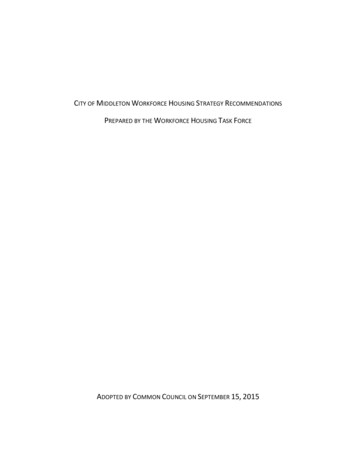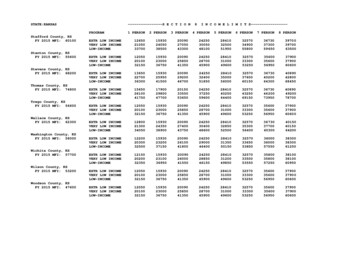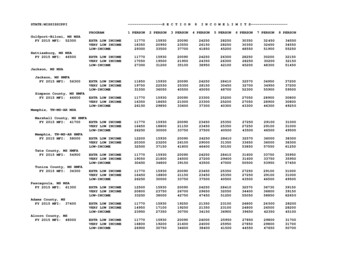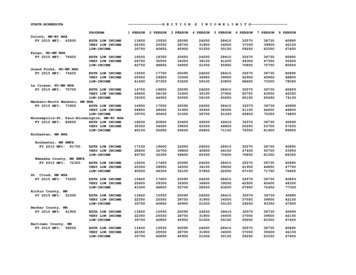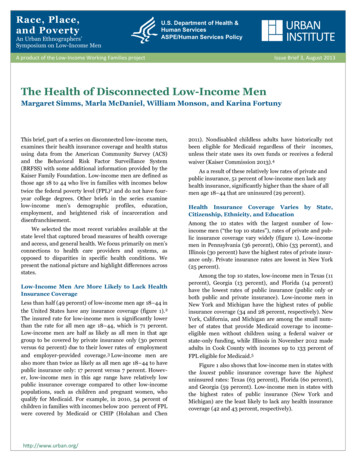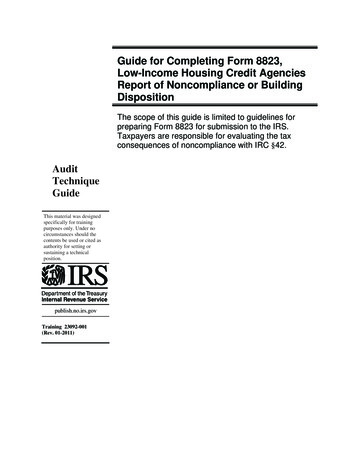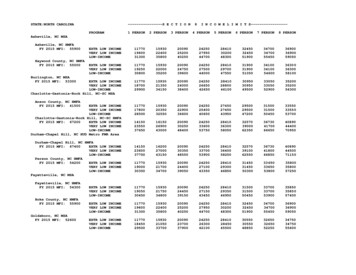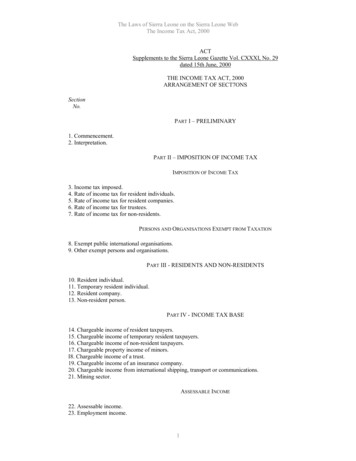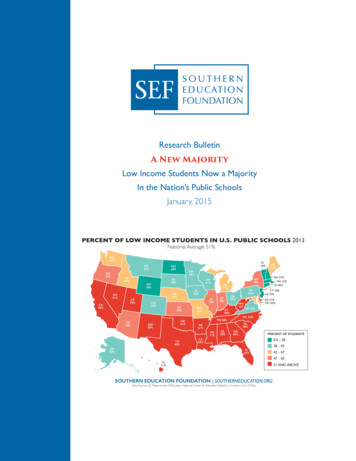
Transcription
Research BulletinA New MajorityLow Income Students Now a MajorityIn the Nation’s Public SchoolsJanuary, 2015PERCENT OF LOW INCOME STUDENTS IN U.S. PUBLIC SCHOOLS 2013National Average: 61%NM68%MO45%AK40%IN49%PA40%OH39%52%NH 27%MA 37%RI 46%CT 36%NJ 37%DE 51%MD 43%WVKY55%VA 39%NC 53%TN RCENT OF STUDENTS0.0 - 38LA65%38 - 42FL59%42 - 4747 - 50HI51%Data Source: U.S. Department of Education, National Center for Education Statistics, Common Core of Data51 AND ABOVE
For the first time in recent history, a majority of the schoolchildren attending the nation’s public schoolscome from low income families. The latest data collected from the states by the National Center forEducation Statistics (NCES), evidence that 51 percent of the students across the nation’s public schoolswere low income in 2013.The pattern was spread across the nation. Half or more of the public schoolchildren in 21 states wereeligible to receive free or reduced-price lunches, a benefit available only to families living in poverty ornear-poverty in 2013.1 In 19 other states, low income students constituted between 40 percent and 49percent of the states’ public school enrollment. In other words, very high proportions of low incomestudents were evident in four-fifths of the 50 states in 2013 (See Appendix 1).This defining moment in enrollment in public education in the United States comes as a consequenceof a steadily growing trend that has persisted over several decades. In 1989, less than 32 percent of thenation’s public school students were low-income. By 2000, the national rate as compiled and calculatedby NCES had increased to over 38 percent. By 2006, the national rate was 42 percent and, after theGreat Recession, the rate climbed in 2011 to 48 percent. NCES data shows that in 2012 the rate of lowincome students was barely below one-half –49.6 percent. In 2013, the rate crossed the threshold ofone half so that in 2013 low income students became a new majority in the nation’s public schools.While found in large proportions throughout the United States, the numbers of low income studentsattending public schools in the South and in the West are extraordinarily high. Thirteen of the 21 stateswith a majority of low income students in 2013 were located in the South, and six of the other 21 stateswere in the West.Mississippi led the nation with the highest rate: 71 percent, almost three out of every four public schoolchildren in Mississippi, were low-income. The nation’s second highest rate was found in New Mexico,where 68 percent of all public school students were low income in 2013.Southern states comprised 12 of the next 14 states with the highest rates of low income students.Louisiana’s rate was 65 percent in 2013, followed by Arkansas and Oklahoma with 61 percent. (Had itbeen granted statehood, the District of Columbia with a rate of 61 percent would have ranked amongthis group and would have made the total count 22 states with a majority of low income students.)Following were Texas and Georgia, where 60 percent of their public schoolchildren were low income.1 This update was developed and written by Steve Suitts, Vice President of the Southern Education Foundation (SEF) with the assistance ofPamela Barba, SEF Graphic Designer, and Katherine Dunn, SEF Program Director. It follows two SEF reports, A New Majority: Low IncomeStudents in the South’s Public Schools (2007) and Update -A New Majority: Low Income Students in the South and Nation (2013). Students areeligible for free meals at public schools if they live in households where the income is no more than 135 percent of the poverty threshold.They are eligible for reduced-price lunches if their household income is no more than 185 percent. In 2013, for example, a student in ahousehold with a single parent with an annual income of less than 19,669 was eligible for a free lunch or less than 27,991 for a reduced-pricemeal in a public school.2- www.southerneducation.org
21 STATES WITH A MAJORITY OF LOW INCOME STUDENTS: 2013MISSISSIPPINEW H CAROLINAWEST 51%FLORIDASOUTH ce: SEF Calculations of NCES Common Core of Data, 2013Among the six Western states with a majority of low income students, Utah (59 percent) and California(55 percent) had especially high rates. Nevada, Arizona, and Hawaii were the remaining, high-rankingWestern states. In each state, 51 percent of the public school children were low income in 2013.Altogether, 57 percent of students in the 15-state South were low income, as were 51 percent of thepublic school students in the 13-state West.The two states outside the South and West with a majority of low income students attending publicschools were Delaware (considered a Southern state in regional counts by the US Census) and Illinoisin the Midwest.In 2013, six other states appeared to be on the verge of reaching a majority of low income students inthe near future, if current trends continue. In Indiana and Oregon, 49 percent of the publicschoolchildren were low income. In New York and Kansas, the rates were 48 percent. In Idaho andMichigan, rates were 47 percent. New Hampshire was the state with the lowest percentage of lowincome students: 27 percent of its public school students were eligible for free and reduced lunches.3- www.southerneducation.org
Implications of the FindingsThe development, implications and consequences of the trends behind these findings have beenexplored and reviewed in prior reports by the Southern Education Foundation, including an updatedresearch report released in October 2013. (See especially pages 11-13 of A New Majority: Low IncomeStudents in the South’s Public Schools (2007) and pages 8-13 of Update -A New Majority: Low IncomeStudents in the South and Nation (2013). A few of the observations from these reports, perhaps, bearrepeating at this moment.After low income children became a majority of the public school students in the Southern states in2006, the SEF report observed: “Currently the South alone faces the implications and consequences ofhaving a new majority of low income students in its public schools the South also faces a new globaleconomy that requires higher skills and knowledge from all who seek a decent living. In this brave, newworld, the people and policymakers of Southern states must realize that continuing the current, unevenlevel of educational progress will be disastrous. They must understand more fully that today their futureand their grandchildren’s future are inextricably bound to the success or failure of low income studentsin the South. If this new majority of students fail in school, an entire state and an entire region will failsimply because there will be inadequate human capital in Southern states to build and sustain good jobs,an enjoyable quality of life, and a well-informed democracy. It is that simple.”In 2013, after reviewing the data, trends, and analysis of student support and achievement for lowincome students, the report concluded:“No longer can we consider the problems and needs of low income students simply a matter of fairness Their success or failure in the public schools will determine the entire body of human capitaland educational potential that the nation will possess in the future. Without improving the educationalsupport that the nation provides its low income students – students with the largest needs and usuallywith the least support -- the trends of the last decade will be prologue for a nation not at risk, but anation in decline “With huge, stubbornly unchanging gaps in learning, schools in the South and across the nation face thereal danger of becoming entrenched, inadequately funded educational systems that enlarge the divisionin America between haves and have-nots and endanger the entire nation’s prospects “The trends of the last decade strongly suggest that little or nothing will change for the better if schoolsand communities continue to postpone addressing the primary question of education in America today:what does it take and what will be done to provide low income students with a good chance to succeedin public schools? It is a question of how, not where, to improve the education of a new majority ofstudents.“Without fundamental improvements in how the South and the nation educate low income students,the trends that this report documents will ricochet across all aspects of American society forgenerations to come. As a wise American leader once reminded a troubled nation: ‘A house dividedagainst itself cannot stand.’”It remains that simple – and yet that profound for the future of the South and the nation.4- www.southerneducation.org
Appendix 1STATE RANKINGS BY PERCENTAGE OF LOW INCOMESTUDENTS IN PUBLIC SCHOOLS: 2013StateMISSISSIPPINEW RIDASOUTH CAROLINATENNESSEEALABAMACALIFORNIAKENTUCKYNORTH CAROLINAWEST OREGONNEW 8%47%47%StateRHODE NACOLORADOWISCONSINPENNSYLVANIAALASKAIOWASOUTH DAKOTAOHIOVIRGINIAMINNESOTAWYOMINGMASSACHUSETTSNEW JERSEYCONNECTICUTVERMONTNORTH DAKOTANEW HAMPSHIRE50 StatesDISTRICT OF COLUMBIAUSASource: SEF Calculations of NCES Common Core of Data, 20135- %61%51%
Appendix 2PERCENTAGE OF LOW INCOME STUDENTS BY REGION AND BY STATE: ISSIPPI64%NORTH CAROLINA 47%OKLAHOMA51%SOUTH CAROLINA 52%TENNESSEE51%TEXAS53%VIRGINIA32%WEST VIRGINIA47%Free/Reduced HAWAIIIDAHOMONTANANEVADANEW AIOWAKANSASMICHIGANMINNESOTAMISSOURINEBRASKANORTH DAKOTAOHIOSOUTH %23%33%32%35%Free/ %NORTHEASTCONNECTICUTDELAWAREMAINEMASSACHUSETTSNEW HAMPSHIRENEW JERSEYNEW YORKPENNSYLVANIARHODE 6%51%43%37%27%37%48%40%46%36%50 STATESDISTRICT OFCOLUMBIAUSA44%58%51%61%44%51%Source: SEF Calculations of NCES Common Core of Data, 20136- www.southerneducation.org
with a majority of low income students in 2013 were located in the South, and six of the other 21 states were in the West. Mississippi led the nation with the highest rate: 71 percent, almost three out of every four public school children in Mississippi, were low-income. The nation's second highest rate was found in New Mexico,

